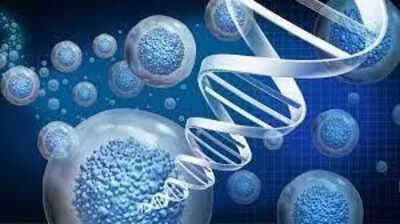Science
Scientists Discover Mechanism for Cell Revival and Tissue Repair

A research team from the CSIR–Centre for Cellular and Molecular Biology (CCMB) in Hyderabad has made a groundbreaking discovery regarding cell revival. Led by Dr. Santosh Chauhan, the scientists revealed a mechanism they term “Programmed Cell Revival,” which enables cells to return from the brink of death and initiate tissue repair. This phenomenon mimics developmental growth, allowing cells to regain full functionality.
The study, recently published in the EMBO Journal, demonstrated that Programmed Cell Revival significantly accelerated wound healing in mouse skin, repaired corneal burns, stimulated tail regeneration in frog tadpoles, promoted nerve repair in worms, and enhanced blood stem cell production in fruit flies. These findings highlight the diverse applications of this mechanism across multiple organisms.
Dr. Chauhan emphasized the implications of their research, stating, “This is not accidental survival of cells. Rather, we find that cells across organisms have the ability to follow a common mechanism that can reactivate their developmental, metabolic, and immune pathways to restore their full cellular function.” The team has filed for both Indian and international patents related to this discovery.
Implications for Regenerative Medicine and Cancer Research
The potential applications of Programmed Cell Revival extend into the field of regenerative medicine. This discovery challenges the long-held notion that once cell death begins, it cannot be reversed. While the research opens new avenues for healing and tissue regeneration, the scientists caution against possible unintended consequences.
Dr. Chauhan noted that cancer drug screenings often rely on superficial indicators of cell death. He warned that cells appearing dead may not be entirely so and could revive with enhanced stem-like properties, potentially leading to more aggressive tumors. “While Programmed Cell Revival mechanisms may be a blessing for regenerative medicine strategies, they possibly reduce the efficacy of cancer treatments,” he said.
This duality of potential benefits and risks underscores the need for further investigation into the implications of their findings. As the scientific community continues to explore the complexities of cell behavior, understanding the intricacies of Programmed Cell Revival will be crucial for both regenerative medicine and oncological therapies.
The team’s work represents a significant advancement in cellular biology, reshaping perspectives on life, death, and healing at the cellular level. As this research progresses, it could lead to revolutionary changes in how medical science approaches tissue repair and regeneration.
-

 World5 months ago
World5 months agoSBI Announces QIP Floor Price at ₹811.05 Per Share
-

 Lifestyle5 months ago
Lifestyle5 months agoCept Unveils ₹3.1 Crore Urban Mobility Plan for Sustainable Growth
-

 Science4 months ago
Science4 months agoNew Blood Group Discovered in South Indian Woman at Rotary Centre
-

 World5 months ago
World5 months agoTorrential Rains Cause Flash Flooding in New York and New Jersey
-

 Top Stories5 months ago
Top Stories5 months agoKonkani Cultural Organisation to Host Pearl Jubilee in Abu Dhabi
-

 Sports4 months ago
Sports4 months agoBroad Advocates for Bowling Change Ahead of Final Test Against India
-

 Science5 months ago
Science5 months agoNothing Headphone 1 Review: A Bold Contender in Audio Design
-

 Top Stories5 months ago
Top Stories5 months agoAir India Crash Investigation Highlights Boeing Fuel Switch Concerns
-

 Business5 months ago
Business5 months agoIndian Stock Market Rebounds: Sensex and Nifty Rise After Four-Day Decline
-

 Sports4 months ago
Sports4 months agoCristian Totti Retires at 19: Pressure of Fame Takes Toll
-

 Politics5 months ago
Politics5 months agoAbandoned Doberman Finds New Home After Journey to Prague
-

 Top Stories5 months ago
Top Stories5 months agoPatna Bank Manager Abhishek Varun Found Dead in Well









